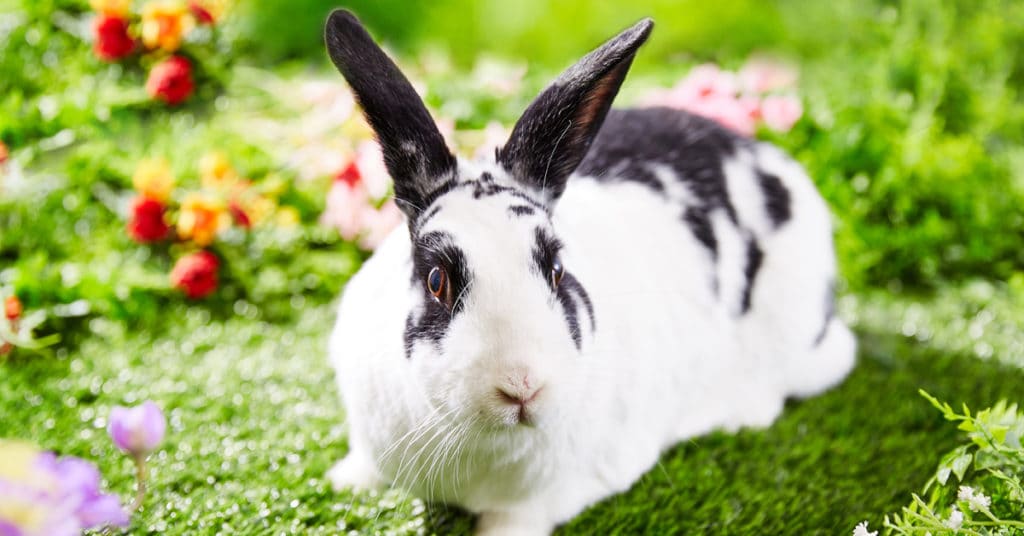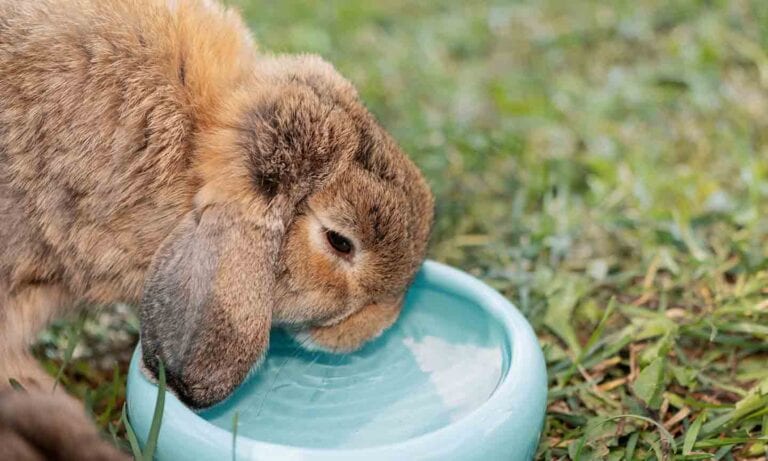Rabbits make fantastic pets for a number of reasons, but if you don’t know how to care for a rabbit, adopting your very first one can be overwhelming. “Rabbits are wonderful companions, but they are not starter pets,” says Natalie L. Reeves, a rabbit advocate and founder of rabbit rescue and education organization Big Apple Bunnies. “They need just as much love and attention as dogs and cats, but they’re more delicate. Also, because their bones can easily break and they often do not like being picked up, rabbits are not always the best pets for children who understandably want to hold them.”
Dr. Tiffany Margolin, DVM, agrees and adds, “Rabbits are very different than almost any animal on earth, as they are domesticated pets, yet they have very little in common with our dogs, cats or birds. In truth, they are most like the horse in that their digestive system is the most important and susceptible part of their bodies when it comes to health.”
On the plus side, your new pet rabbit will be intelligent, quiet and friendly, and will return all the love you provide to it, Reeves adds. If you’ve done your research and think you’re ready for a new pet rabbit, keep some of these bunny care basics in mind before bringing your new pet bunny home. Here’s everything you need to know about how to care for a rabbit:
How to Care for a Rabbit
Your new pet bunny will require some very specific things to keep them safe and happy in their new home. “Rabbits need a safe space indoors where they will be part of the family,” says Reeves. To that end, she suggests providing the following:
1. Rabbit Housing
Reeves likes to provide rabbits with cages that have a large exercise pen and at least 4 by 4 feet of space with enough room for a litter box. Reeves also suggests heavy crocks for clean water and food and at least one space for them to hide (like the Ware Edible Twig Tunnel Hideout). “Many bunnies love the duplex and triplex condos, too,” says Reeves.
Whatever enclosure you go with, the floor should have flat areas that are not wire so your bunny won’t get sores on the feet or hocks, Dr. Margolin adds. You’ll need bedding as well, she says, and a recycled, soft paper litter works well. CareFresh Custom Guinea Pig & Rabbit Natural Paper Bedding is a good option.
Keep in mind that when your new pet rabbit isn’t in their home, they’ll need some traction to run around, so if you have hardwood or tile floors, you might consider putting down some area rugs for the spaces where your rabbit will play.
2. Rabbit Handling
At the beginning, new bunny parents shouldn’t try to handle their rabbits more than necessary, Reeves cautions. Some rabbits will love to be held, but most do not. “Play a little hard to get,” she suggests. “Lie down on the floor near the bunny and read a book. Eventually your bunny will be curious and want to come see you. Pet her on the head and rub her cheeks or upper back. Most don’t like to be touched near the tail area.”
Once your rabbit is used to you, you can start playing games. Spend as much time as possible with your rabbit, says Reeves. They love attention, and are generally most active in the mornings and evenings.
3. Rabbit Health
Rabbits can live to be 13 or more years old with quality care, but their average lifespan is less. “They should be spayed or neutered, something that is usually already taken care of if you adopt from a shelter or rescue group,” says Reeves. In fact, unspayed female bunnies have almost a 100 percent chance of uterine cancer, says Dr. Margolin, which you can prevent by spaying. Your new pet bunny will need a wellness examination by a rabbit-savvy veterinarian at least once a year.
“The most important thing a new rabbit guardian can do is to know his rabbit and if there is a change in behavior, particularly in his eating habits, go to the vet,” says Reeves. “Rabbits are prone to get gastrointestinal ailments [which can be fatal] if not treated successfully.” Dr. Margolin adds, “you must be rigorous about their nutrition, and check them daily for any small changes in appetite or stools, as they can get into big medical trouble fast if their gut fails them.”
Try to feed your bunny at about the same time each day, measure their food, and if you notice that they aren’t finishing it in the usual time, you may need to make a trip to the vet. Dr. Margolin also suggests making a grooming appointment daily with your bunny to look underneath and through their hair for any problems. “Rabbits are also very prone to heatstroke,” adds Dr. Margolin. “If the weather is warm, always supply a cool, frozen liter bottle or two of ice for your bunny to lean on.”
4. Rabbit Nutrition
The most important component of a rabbit’s diet is grass hay, such as timothy hay (like Kaytee Timothy Hay Wafer-Cut) or orchard grass. “Stay away from alfalfa hay unless your rabbit is a baby,” says Reeves.
Adult rabbits can feed on rabbit pellets like Oxbow Essentials Bunny Basics Adult Rabbit Food, but be sure to always consult with your vet before changing your new pet rabbit’s diet. “If you want to feed pellets, use 1/3 cup per day of timothy pellets per rabbit,” the vet recommends. Keep in mind that the amount of food you should give to your rabbit per day depends largely on their weight. Also, if feeding rabbit food, “they should never have pellets as a core part of the diet,” Dr. Margolin says.
To supplement your rabbit’s diet, try leafy greens. According to Reeves, “Rabbits can get fresh greens as a treat, but not all rabbits can tolerate them. Start slowly by introducing one green, like Italian parsley, to your rabbit’s diet for a few days. If he enjoys them and does well, you can move on to other greens.” Dr. Margolin suggests trying a salad of fresh red leaf lettuce, cilantro or dandelion greens daily, as well. “This is usually a handful per rabbit,” she says. Carrots, believe it or not, are not good for your bunny, says Dr. Margolin, as they have too much sugar. Your bunny might also enjoy other treats, like the Oxbow Simple Rewards Oven Baked Apple & Banana Treats, but, again, start slowly when introducing them.
Your rabbit will also need constant access to a large, heavy crock of clean water. “Hanging water bottles can work,” says Dr. Margolin, “but I prefer you buy ceramic non-tip bowls for water so they don’t collect algae and bacteria as they can in plastic water bottles.”
5. Rabbit Training
Most rabbits can be litter trained, says Reeves, but they should be spayed or neutered first. “In fact, they are so smart that they basically train themselves with the right setup,” she says. “Provide them a large cat litter box, line it with a few layers of newspaper, and top it off with lots of grass hay. Stay away from clay litters or pine or cedar shavings.”
6. Rabbits With Other Animals and Kids
Worried about how to care for a rabbit if you have other animals or kids? Here’s the good news: Most rabbits actually prefer to have a bonded pal to hang out with, says Reeves. “But you can never just put two rabbits together,” she cautions. “Bonding can be time consuming, but it’s worth it.” For bonding to work, Reeves says the rabbits should both be spayed or neutered, and you should try to let your rabbit choose their own friend on a date arranged by a local rabbit rescue.
“Many rescues throughout the country have rabbit speed-dating events where they help bunnies find love,” says Reeves. “After these events, the rabbit guardians may still have to work with their bunnies for months to build their bond.” Be sure to consult your vet for advice before bringing home a second bunny.
Many rabbits also share homes well with dogs and cats, but since rabbits are prey animals, they should never be left alone with another pet. When it comes to kids, children can often be taught gentle handling techniques for bunnies, but remember that you are the caretaker, says Dr. Margolin, so you should not depend on your child to manage bunny care.
“Younger bunnies go best with younger folks, so match your child’s energy,” she suggests. “Do not adopt an elderly bunny if you have a rambunctious youngster. If you are mixing kids and any pets, please have regular fecal exams performed to prevent transmissions of parasites to your children.”
While learning how to care for a rabbit might seem to involve a daunting number of things to keep in mind, rest assured that rabbits can be amazing and wonderfully rewarding pets, says Dr. Margolin. “They are introverted, playful and fascinating to watch,” she says. “Please try to adopt from a bunny rescue organization as there are so many unwanted and abandoned rabbits out there.”
And if you’re ready to bring a new rabbit home, be sure to check out our guide on how to house rabbits indoors.
Read More
Share:















